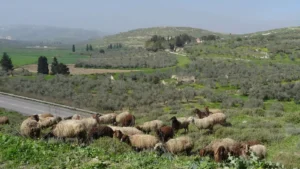Taking over Palestinian historical sites and turning them into Israeli tourist attractions is just another way the occupation grabs land. Unesco must step in to save Tel Sebastia

The ancient site of Tel Sebastia, in the occupied West Bank, as seen by the writer on her visit in the spring of 2016 (Diana Darke)
Diana Darke writes in Middle East Eye 5 September 2024
“Israel seizes cultural site in West Bank.” So read a recent headline in the Financial Times, going on to describe how the Israeli military had seized a plot of Palestinian land at the summit of Tel Sebastia, a site rich with archaeological significance and tourism potential.
In 2012, Palestine submitted an application for Sebastia to gain Unesco World Heritage status on the basis of its ancient remains from the Iron Age, Persian, Hellenistic, Roman, Byzantine and Islamic periods.
Israel’s heritage ministry, on the other hand, confirmed plans to erect a “gigantic” Israeli flagpole there, for unspecified “military needs”, according to a document seen by the Financial Times.
“The seizure this month,” the FT writes, “was one of several moves by Prime Minister Benjamin Netanyahu’s far-right government to expand control over cultural heritage sites in the West Bank, alongside numerous moves to expand Jewish settlements and entrench Israel’s presence in the occupied territory.”
Cultural heritage can be a powerful tool. It is, of course, standard practice for countries to use it to enhance their own national identity and image.
But in the case of Israel, the land is not owned by them, but illegally occupied, according to the 19 July 2024 opinion of the International Court of Justice in The Hague. The land grab took place just days before, on 10 July.
Throughout my lifetime, I have visited virtually every cultural heritage site in the occupied West Bank, independently and unescorted, with varying degrees of difficulty, thanks to the obstacles the Israeli state routinely puts in the way.
None was more difficult than my visit to Sebastia, in spring 2016. Citing “security concerns”, Israel’s objective appears to be preventing tourism revenue from reaching the Palestinians.
Dangerous and forbidden
There are no public railways, metros, trams or public buses in the West Bank (or Gaza), as there are in Israel, and car rental is far from straightforward. Finding a hire car insurable in both Israel and the West Bank is the first challenge. From Tel Aviv airport, it is impossible.
I eventually found a small company in East Jerusalem able to offer dual insurance. Maps are another problem. Israeli tourist maps show the West Bank as a near blank, with barely any roads. GPS is limited and apps such as Waze, originally developed in Israel, simply stop when you cross from Israel into the West Bank, informing you it is dangerous and forbidden to Israeli citizens. Google Maps is equally misleading.
My first attempt to cross the Israeli West Bank barrier (known by Palestinians as “the wall of apartheid”) was at the Tulkarm crossing point.
I was denied access by Israeli soldiers, without explanation, and left with no alternative but to drive 50km south to a point where there was no checkpoint on entry, a detour that took nearly two hours.
Finally, just as I was within a few kilometres of my destination, an Israeli military jeep appeared in my rearview mirror, chasing me and forcing my car over to the roadside. Two young armed soldiers got out, and aggressively told me to turn back, as it was “too dangerous” to visit Sebastia.
They made me turn the car around, even driving behind me for some five kilometres to ensure that I obeyed.
Once their jeep had dropped back, I stopped the car and phoned the Palestinian owner of the guesthouse in Sebastia where I had booked to stay a few nights. He assured me there was no danger at all, took details of where I was and within 15 minutes came to meet me, in a local taxi, which then led the way to Sebastia via a back route, away from Israeli checkpoints.
Once at Sebastia, my family and I enjoyed several peaceful days’ walking in the hills, without a guide. We felt safe at all times, even leaving the rental car and hotel rooms unlocked. Our Palestinian host was warmth and hospitality personified.
The cultural site itself was tranquil, too, except when busloads of Israeli tourists arrived, complete with military escort, no doubt having been informed that it was “too dangerous” to visit any other way.
There were no fences or entry tickets.
More …

